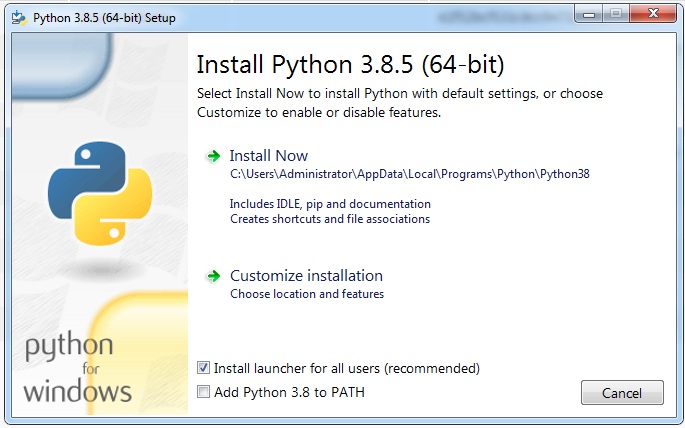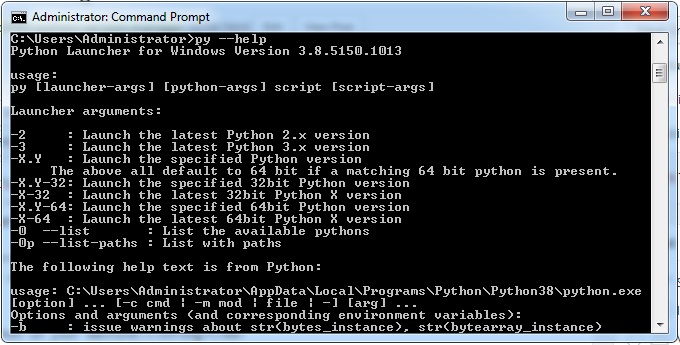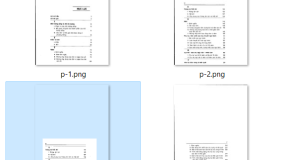For Ruby, we have RVM – Ruby Version Manager and for NodeJS we have NVM – Node Version Manager.
Which is the Python version manager?
There are many methods, but we say about the simplest method: use py.exe locate at C:\Windows\py.exe
List all available python on your machine:
C:\Windows\py.exe
Result:
C:\Users\Administrator>py -0 Installed Pythons found by py Launcher for Windows -3.8-64 * -3.7-64 -2.7-64
Full help about py.exe:
C:\Users\Administrator>py --help
Python Launcher for Windows Version 3.8.5150.1013
usage:
py [launcher-args] [python-args] script [script-args]
Launcher arguments:
-2 : Launch the latest Python 2.x version
-3 : Launch the latest Python 3.x version
-X.Y : Launch the specified Python version
The above all default to 64 bit if a matching 64 bit python is present.
-X.Y-32: Launch the specified 32bit Python version
-X-32 : Launch the latest 32bit Python X version
-X.Y-64: Launch the specified 64bit Python version
-X-64 : Launch the latest 64bit Python X version
-0 --list : List the available pythons
-0p --list-paths : List with paths
The following help text is from Python:
usage: C:\Users\Administrator\AppData\Local\Programs\Python\Python38\python.exe
[option] ... [-c cmd | -m mod | file | -] [arg] ...
Options and arguments (and corresponding environment variables):
-b : issue warnings about str(bytes_instance), str(bytearray_instance)
and comparing bytes/bytearray with str. (-bb: issue errors)
-B : don't write .pyc files on import; also PYTHONDONTWRITEBYTECODE=x
-c cmd : program passed in as string (terminates option list)
-d : debug output from parser; also PYTHONDEBUG=x
-E : ignore PYTHON* environment variables (such as PYTHONPATH)
-h : print this help message and exit (also --help)
-i : inspect interactively after running script; forces a prompt even
if stdin does not appear to be a terminal; also PYTHONINSPECT=x
-I : isolate Python from the user's environment (implies -E and -s)
-m mod : run library module as a script (terminates option list)
-O : remove assert and __debug__-dependent statements; add .opt-1 before
.pyc extension; also PYTHONOPTIMIZE=x
-OO : do -O changes and also discard docstrings; add .opt-2 before
.pyc extension
-q : don't print version and copyright messages on interactive startup
-s : don't add user site directory to sys.path; also PYTHONNOUSERSITE
-S : don't imply 'import site' on initialization
-u : force the stdout and stderr streams to be unbuffered;
this option has no effect on stdin; also PYTHONUNBUFFERED=x
-v : verbose (trace import statements); also PYTHONVERBOSE=x
can be supplied multiple times to increase verbosity
-V : print the Python version number and exit (also --version)
when given twice, print more information about the build
-W arg : warning control; arg is action:message:category:module:lineno
also PYTHONWARNINGS=arg
-x : skip first line of source, allowing use of non-Unix forms of #!cmd
-X opt : set implementation-specific option. The following options are available
:
-X faulthandler: enable faulthandler
-X showrefcount: output the total reference count and number of used
memory blocks when the program finishes or after each statement in
the
interactive interpreter. This only works on debug builds
-X tracemalloc: start tracing Python memory allocations using the
tracemalloc module. By default, only the most recent frame is store
d in a
traceback of a trace. Use -X tracemalloc=NFRAME to start tracing wi
th a
traceback limit of NFRAME frames
-X showalloccount: output the total count of allocated objects for each
type when the program finishes. This only works when Python was bui
lt with
COUNT_ALLOCS defined
-X importtime: show how long each import takes. It shows module name,
cumulative time (including nested imports) and self time (excluding
nested imports). Note that its output may be broken in multi-thread
ed
application. Typical usage is python3 -X importtime -c 'import asyn
cio'
-X dev: enable CPythonâ?Ts â?odevelopment modeâ??, introducing addition
al runtime
checks which are too expensive to be enabled by default. Effect of
the
developer mode:
* Add default warning filter, as -W default
* Install debug hooks on memory allocators: see the PyMem_SetupD
ebugHooks() C function
* Enable the faulthandler module to dump the Python traceback on
a crash
* Enable asyncio debug mode
* Set the dev_mode attribute of sys.flags to True
* io.IOBase destructor logs close() exceptions
-X utf8: enable UTF-8 mode for operating system interfaces, overriding
the default
locale-aware mode. -X utf8=0 explicitly disables UTF-8 mode (even w
hen it would
otherwise activate automatically)
-X pycache_prefix=PATH: enable writing .pyc files to a parallel tree ro
oted at the
given directory instead of to the code tree
--check-hash-based-pycs always|default|never:
control how Python invalidates hash-based .pyc files
file : program read from script file
- : program read from stdin (default; interactive mode if a tty)
arg ...: arguments passed to program in sys.argv[1:]
Other environment variables:
PYTHONSTARTUP: file executed on interactive startup (no default)
PYTHONPATH : ';'-separated list of directories prefixed to the
default module search path. The result is sys.path.
PYTHONHOME : alternate <prefix> directory (or <prefix>;<exec_prefix>).
The default module search path uses <prefix>\python{major}{minor}
.
PYTHONCASEOK : ignore case in 'import' statements (Windows).
PYTHONUTF8: if set to 1, enable the UTF-8 mode.
PYTHONIOENCODING: Encoding[:errors] used for stdin/stdout/stderr.
PYTHONFAULTHANDLER: dump the Python traceback on fatal errors.
PYTHONHASHSEED: if this variable is set to 'random', a random value is used
to seed the hashes of str and bytes objects. It can also be set to an
integer in the range [0,4294967295] to get hash values with a
predictable seed.
PYTHONMALLOC: set the Python memory allocators and/or install debug hooks
on Python memory allocators. Use PYTHONMALLOC=debug to install debug
hooks.
PYTHONCOERCECLOCALE: if this variable is set to 0, it disables the locale
coercion behavior. Use PYTHONCOERCECLOCALE=warn to request display of
locale coercion and locale compatibility warnings on stderr.
PYTHONBREAKPOINT: if this variable is set to 0, it disables the default
debugger. It can be set to the callable of your debugger of choice.
PYTHONDEVMODE: enable the development mode.
PYTHONPYCACHEPREFIX: root directory for bytecode cache (pyc) files.
Some examples:
C:\Users\Administrator>py -2.7 -V Python 2.7.15 C:\Users\Administrator>py -3.7 -V Python 3.7.9 C:\Users\Administrator>py -V Python 3.8.5
Note: When install Python, do not check at Add Python X.X to PATH

PIP – Python package manager
For pip, how to switch version?
Command: py -{version} -m pip
Example:
C:\Users\Administrator>py -m pip -V pip 20.1.1 from C:\Users\Administrator\AppData\Local\Programs\Python\Python38\li b\site-packages\pip (python 3.8) C:\Users\Administrator>py -3.7 -m pip -V pip 20.1.1 from C:\Users\Administrator\AppData\Local\Programs\Python\Python37\li b\site-packages\pip (python 3.7) C:\Users\Administrator>py -2.7 -m pip -V pip 9.0.3 from C:\Users\Administrator\.windows-build-tools\python27\lib\site-pac kages (python 2.7)





